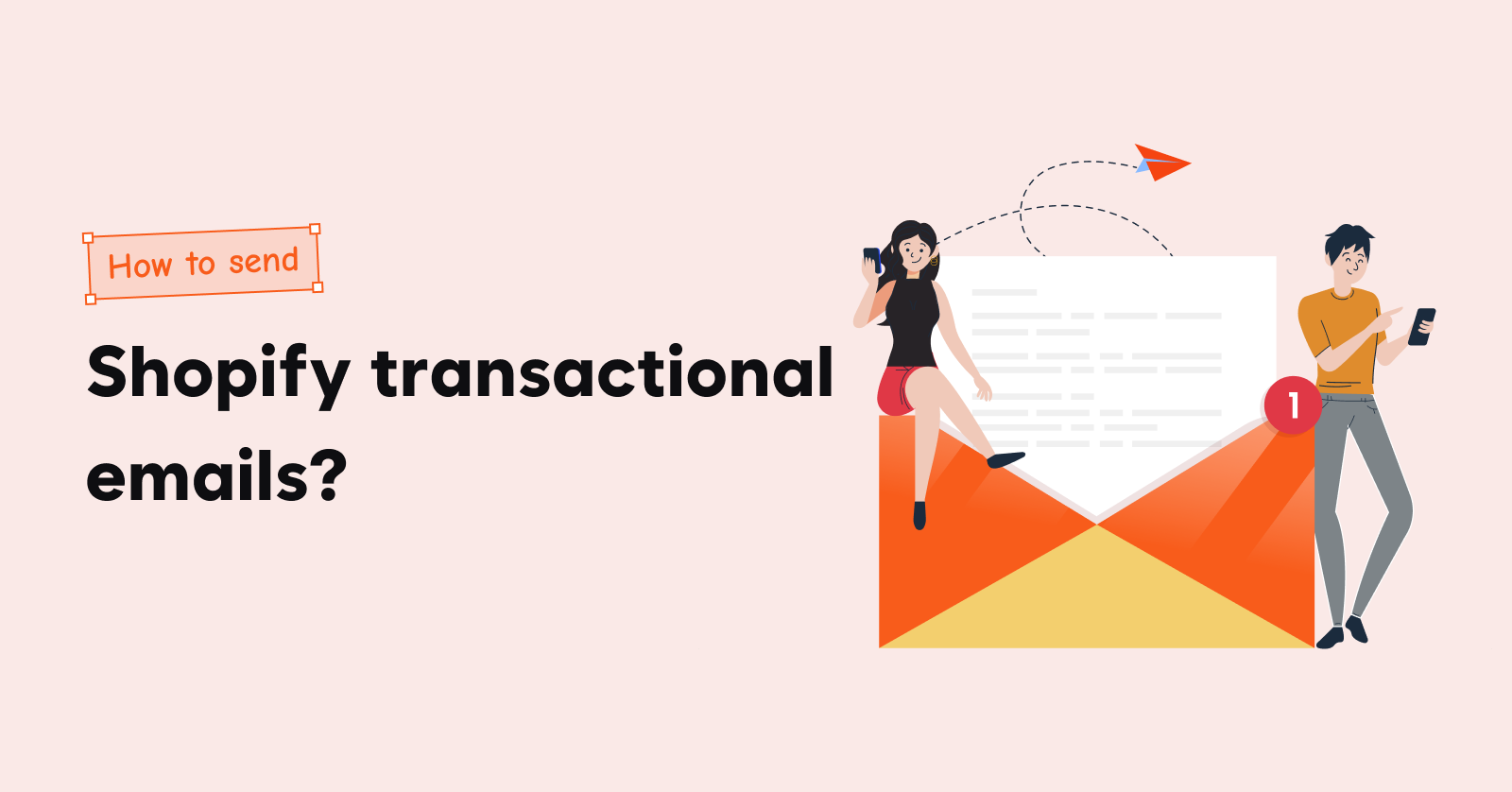Shopify Email vs Mailchimp – both promise to make life easier for e-commerce store owners like you, but do they truly deliver?
Shopify Email promises cost-effectiveness and seamless integration, while Mailchimp flaunts advanced automation and in-depth analytics.
But which one really tackles your biggest headaches – limited time, tight budgets, and the unrelenting push for conversions?
In this blog, we’ll unpack Shopify email marketing vs Mailchimp pros, cons, pricing structure, feature-by-feature comparison to help you choose the right solution for your e-commerce goals.
Looking for simpler pricing and easy-to-setup automation? – Choose Retainful and send emails with zero hassle.
Shopify Email Vs. Mailchimp – An Overview
While doing Shopify email marketing, you want to spend less time learning the tool and more time optimizing email campaigns.
| Criteria | Shopify Email | Mailchimp |
| Free plan | Requires a paid Shopify Plan No additional cost upto 10,000 emails | Max of 1,000/mo or 500/day |
| Pricing plans | Billing based on email sends | Billing based on contacts |
| Email automation | Basic and single-step automation | Multi-step automation with conditional splits |
| Email templates | Limited ready-made templates | Very extensive template library for varied specific category like beauty, electronics and more. |
| Integration | Integrates with Shopify | Integrates with Shopify and other Shopify apps |
Shopify Email and Mailchimp Pros and Cons
1. Shopify Email
Pros:
- Beginner-friendly interface: You won’t get overwhelmed by advanced features and complex workflows.
- Native Shopify integration: Ease of syncing up data like purchase history, products in the store and events.
- Affordable Pricing: The first 10,000 emails sent per month are free along with Shopify paid plan, and after that, it’s priced at $1 for every additional 1,000 emails. This is a major benefit for Shopify users with a smaller email list.
Cons:
- Limited Features: Compared to Shopify email marketing platform like Mailchimp, Shopify Email lacks advanced features such as A/B testing, detailed analytics, and more complex automation options.
- No Free Plan: While you get 10,000 free emails per month in a paid Shopify plan, there’s no free plan for ongoing use. This may be a turn-off for those looking for a completely free solution.
- Basic Email Editor: While Shopify offers a straightforward email editor, it’s more basic when compared to other platforms. Customization for Shopify email template design and layout are somewhat limited.
Here is a customer review about switching from Mailchimp to Shopify Email:
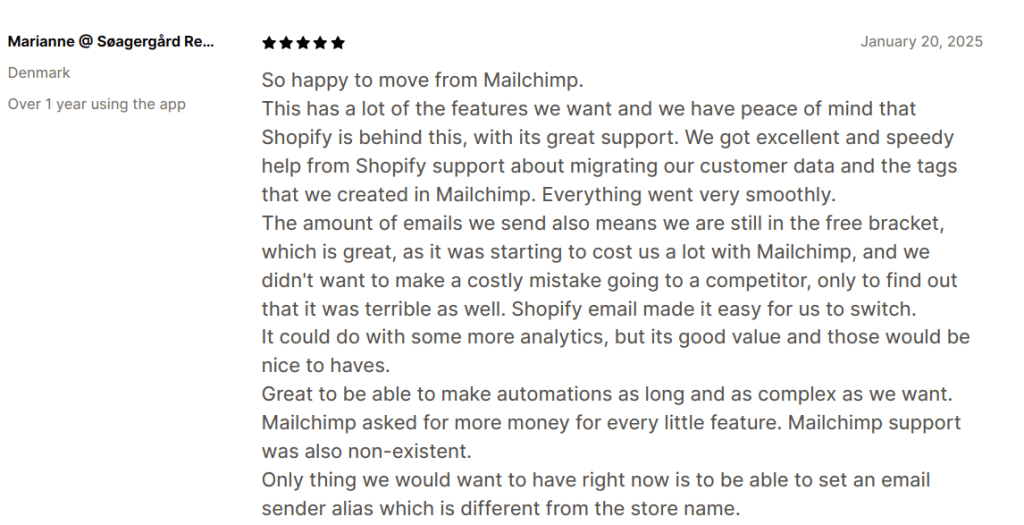
2. Mailchimp
Pros:
- Advanced Email automation and triggers: Mailchimp provides a wealth of email automation options including sending automated emails based on products viewed, search for a specific item in your Shopify store.
- Advanced Design Tools: The Mailchimp editor is far more flexible than Shopify Email’s, allowing for rich design capabilities. You can create more complex, personalized email templates and layouts.
Cons:
- Lack of generous free plan: Offers only single-step automation in Free and Essential plans. Transactional emails are not included in the Free and Essential plans.
- Learning Curve: Due to the wide range of features, Mailchimp can be overwhelming for new users.
Pricing Comparison of Shopify Email vs Mailchimp
1. Shopify Email – Pricing Structure
- Included with Shopify: There’s no separate monthly subscription specifically for Shopify Email. You just need any paid Shopify plan (Basic, Shopify, Advanced, or Plus).
- Free Monthly Email Sends: You typically get 10,000 free emails per month.
- Per-Email Cost: After the free monthly allocation, emails cost around $0.001 USD per email (i.e., $1 per 1,000 emails).
2. Mailchimp – Pricing Structure
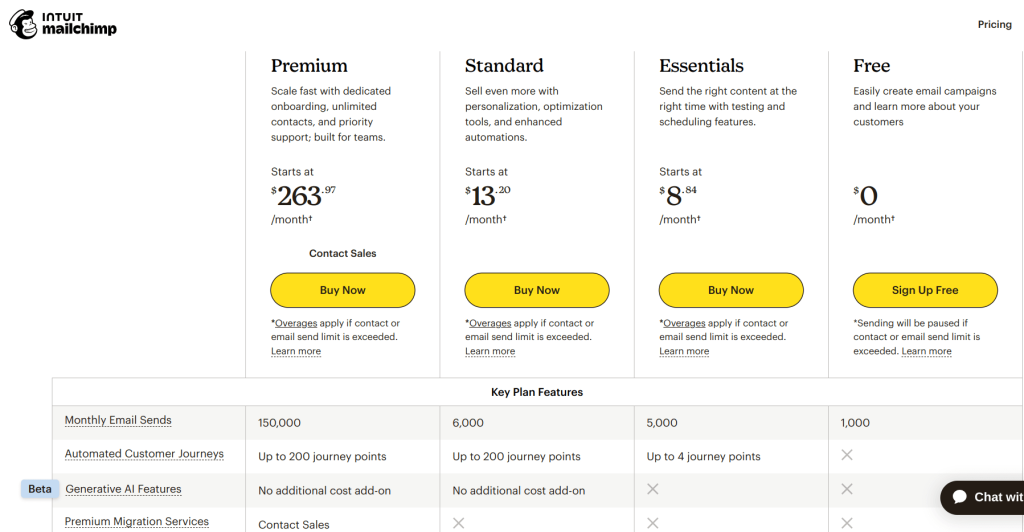
Mailchimp Free plan:
- 500 contacts
- Max of 1,000/mo or 500/day
- Basic email templates and design tools.
- 1 audience.
- Email support (for the first 30 days after signing up).
- Basic reporting and analytics.
- Access to Mailchimp’s website builder and landing pages.
You get only email support for the first 30 days.
When it comes to automation, you get to create only single-step automation in both Free and Essential plan.
Also, you get to build forms and landing pages even in the Free plan.
Mailchimp Paid plans:
Here is how Mailchimp pricing scales in its paid plans:
| Contacts | Essential plan | Standard plan |
| 5000 | $44.19 | $66.57 |
| 10,000 | $66.57 | $87.23 |
| 50,000 | $229.54 | $263.97 |
MailChimp pricing overview:
| Plan | Price | Subscribers Limit | Email Sends per Month | Key Features |
| Free | $0 | 500 | 500 | Basic features, limited templates, single step automations |
| Essentials | Starts at $13/month | 50,000 | 10X contacts | A/B testing, email support, single step automation |
| Standard | Starts at $20/month | 100,000 | 12X contacts | Advanced segmentation, multi-step automations |
| Premium | Starts at $350/month | Unlimited | 15X contacts | Advanced segmentation, predictive analytics, priority support |
Feature comparison of Shopify Email and MailChimp
1. Email automation
Shopify Email:
To create email automation workflows in Shopify Email, you need to integrate it with Shopify Flow app.
With only Shopify Email, you can send email campaigns/newsletters like product launch emails, announcements seasonal sale emails and more.
Shopify Email, while a great entry-level tool, has a more basic automation setup compared to Mailchimp. However, when paired with Shopify Flow (for Shopify Plus users), it offers more flexibility, though it still doesn’t match the customization depth of Mailchimp.
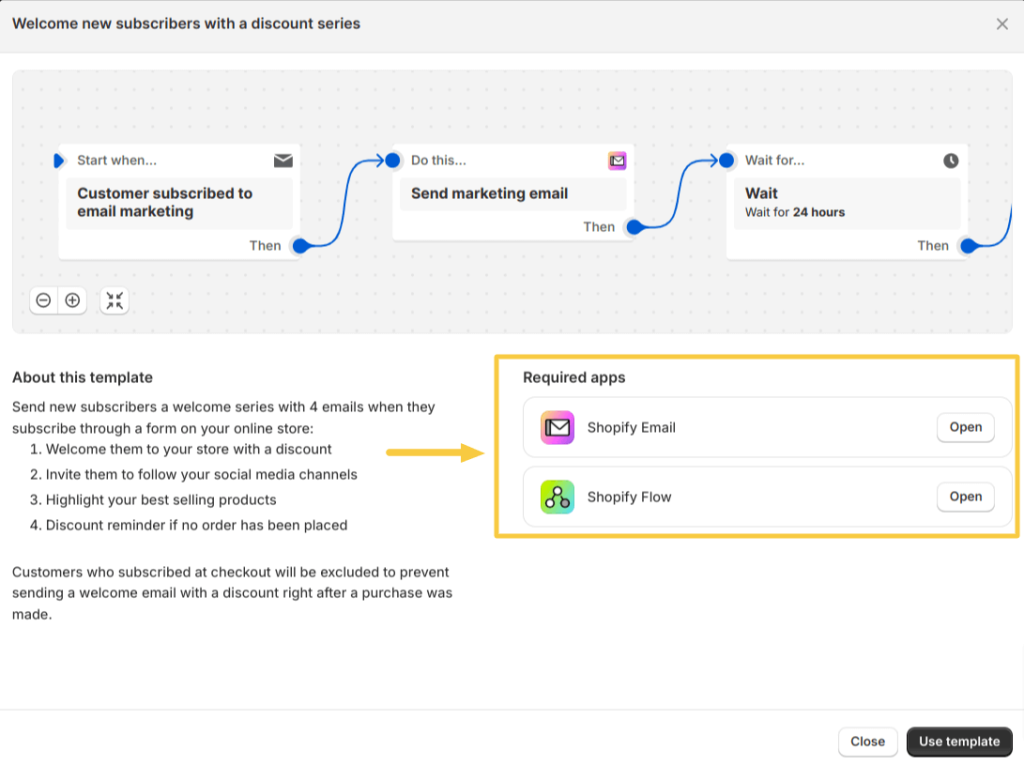
Mailchimp:
Mailchimp’s visual automation builder is very intuitive and easy to set up. It doesn’t let you do the heavy lifting. It has pre-configured triggers, email content, time delay. Make some tweaks, and you are good to go.
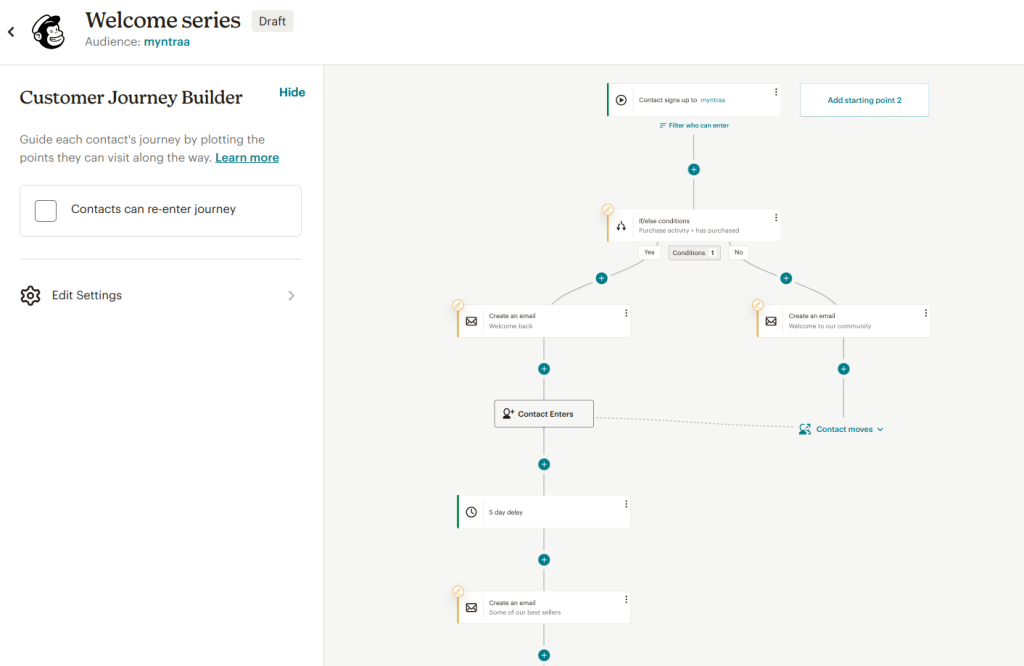
You can create custom workflows based on user behavior, allowing emails to be tailored to specific actions (e.g., if a customer opens an email, you can trigger a follow-up email offering a related product).
Mailchimp provides built-in A/B testing for email subject lines, content, and sending times, so you can test different email marketing strategies to optimize performance.
2. Template customization
Shopify Email:
Shopify Email lacks the deep customization options that Mailchimp offers. The available design features are limited to basic color schemes, font options, and alignment.

Mailchimp:
You get email templates are also categorized by industry (e.g., e-commerce, fashion, food & beverage), allowing you to choose designs that align with your specific market.
Select a connected store and showcase recommendations for products a customer has in their cart, best sellers, new arrivals, most viewed, and more.
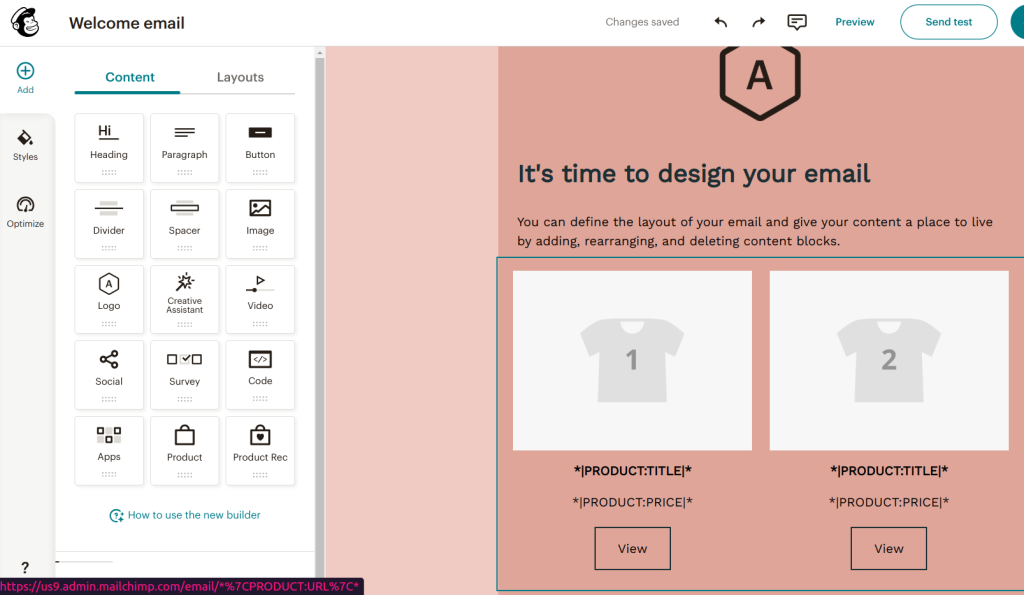
Mailchimp’s content blocks enable you to create highly customizable Shopify emails. You get content blocks like: product blocks, social media blocks, surveys & polls.
For those with coding knowledge, Mailchimp also supports custom HTML blocks, which is ideal for advanced email designs or inserting complex content that cannot be done using drag-and-drop blocks.
3. Email personalization and dynamic content
Shopify Email:
Basic merge tags (customer name, order information) are possible, but dynamic recommendation blocks and advanced email personalization are limited compared to Mailchimp.
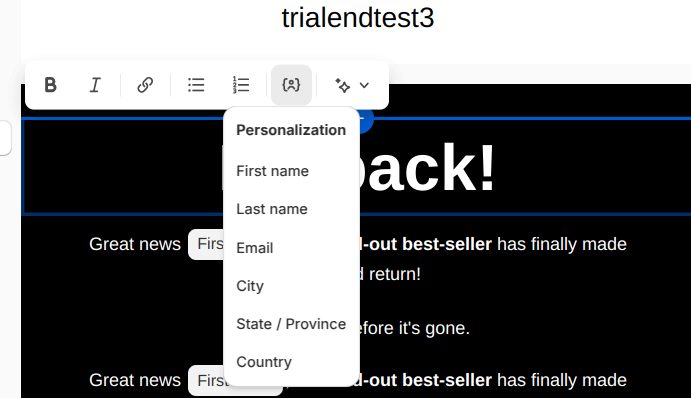
Mailchimp:
Mailchimp allows you to display different content depending on the recipient’s segment or behavior. For instance, you can show different products based on a user’s past purchase or browsing history.
You can use custom merge tags (e.g., customer’s first name, address etc.) to automatically insert personalized elements into your marketing emails.
4. Customer support
Because Shopify Email is part of the larger Shopify ecosystem, you generally rely on Shopify’s main support team for help. This includes 24/7 support via live chat, email, and phone.
If you need advanced email marketing expertise, multi-step automation, and deeper guidance on strategy, Mailchimp’s specialized support can be a stronger fit.
3 Best Shopify Email and Mailchimp Alternatives
1. Retainful
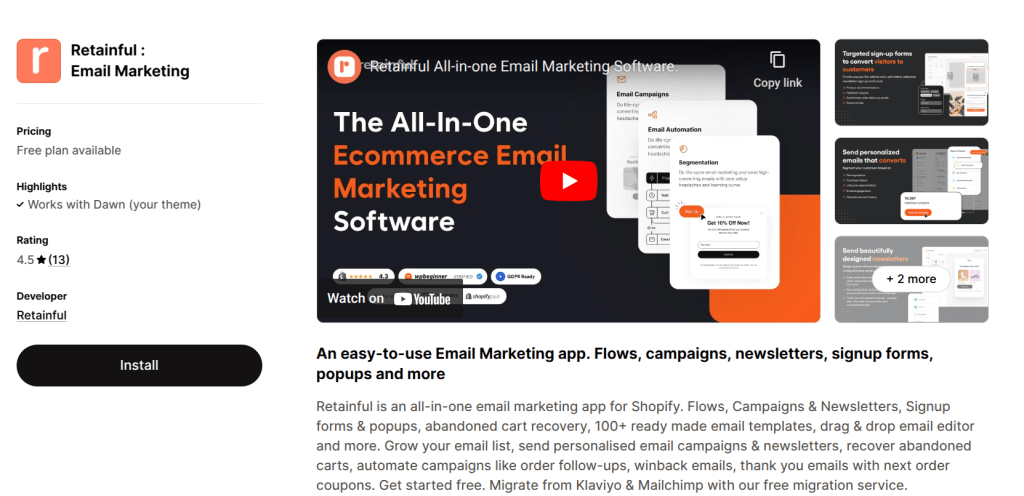
Retainful is the best email marketing app for Shopify tailor-made for e-commerce businesses. It is an all-in-one platform to cover all your bases in email marketing – acquire, nurture, and retain customers.
With its abandoned cart recovery feature, you can get up to a 30% recovery rate.
It has easy-to-setup automation that doesn’t require a 3-page manual to configure and go live.
Customize Shopify emails without any hassle with an intuitive drag-and-drop email editor and ready-made email templates.
Here is how Retainful compares to Mailchimp:
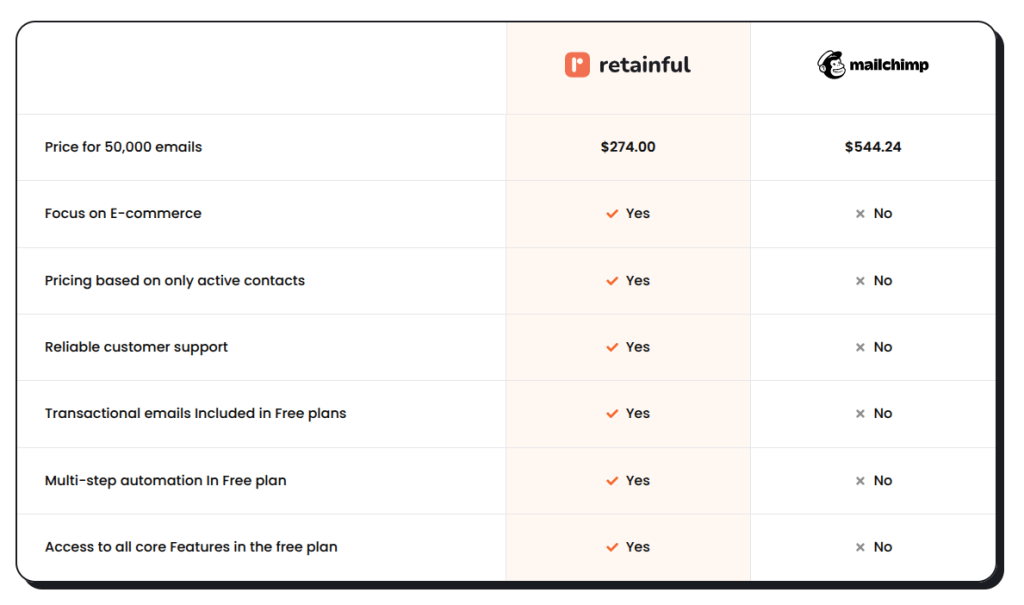
Compare and Decide: Check out out detailed comparison between Retainful and Mailchimp: Retainful vs Mailchimp – An Honest Comparison:
- Forever Free plan – 500 emails/month
- $19/month – 20,000 email/month
- $49/month – 50,000 emails/month
2. Omnisend

Omnisend is an omnichannel marketing platform for Shopify that is tailored to e-commerce businesses. It allows you to set up automation workflows for creating promotional emails, cart abandonment emails, post-purchase, welcome emails, and more.
It allows you to include dynamic content in your Shopify emails using customer data and behavior, ensuring each recipient receives a tailored message.
This Shopify email marketing service offers an email template library, or you can create one on top of the pre-built layout.
Price tiers and Email Volume:
- Free plan: 500 Emails
- $16/month: 6000 Emails
- $59/month: Unlimited Emails
3. Yotpo
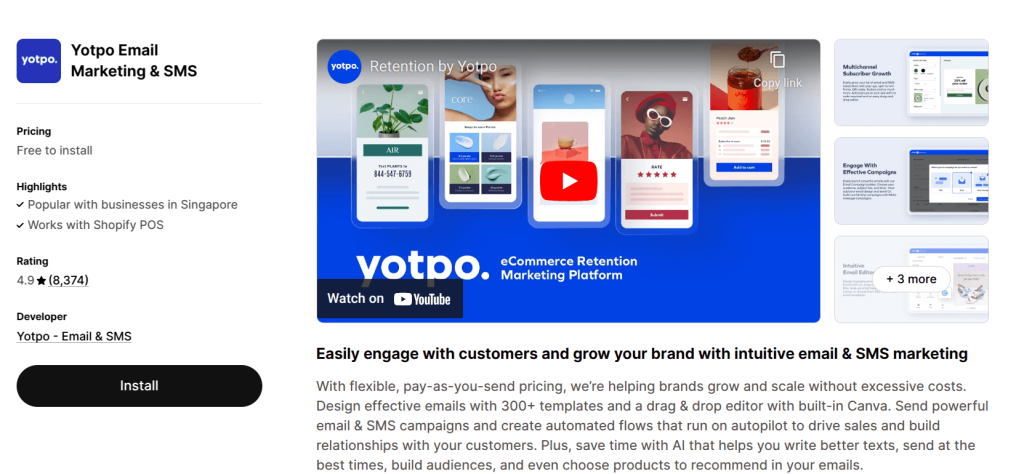
Yotpo Email integrates reviews, UGC, loyalty, and email marketing in one platform.
You can segment and target customers based on user engagement (reviews submitted, loyalty points, etc.), leading to more effective campaigns.
In Yotpo, the billing is based only on the emails sends not contacts.
Pricing:
- Free – 10,000 emails
- $15/month – 20,000 emails/month
- $135/month – 100,000 emails/month
Advanced than Shopify Email and more ecommerce-focused than Mailchimp – switch to Retainful with free migration.
Wrapping up!!
Shopify Email is simple, cost-effective, and built right into your store. If you’re a newcomer who wants the basics—like free sends, easy setup, and zero code – go for Shopify Email. But if you need advanced email automation, A/B testing, and segmentation, you’ll outgrow it fast.
The real question is: how big are your email marketing ambitions? Sometimes, a lightweight solution like Shopify Email works.
Choose a Shopify email marketing app like Retainful that is built for ecommerce, has simpler pricing, and affordable email marketing.
Also Read:
- Shopify Email vs Klaviyo: A Detailed Review – Retainful
- Ecommerce Email Marketing: Strategies + Software
- Shopify Marketing Automation – A Complete Guide (+Apps)
- 9 Post-Purchase Email Examples that Retain Customers
Frequently Asked Questions
Shopify Email is simpler and more cost-effective but lacks Mailchimp’s advanced features like segmentation, A/B testing, and automation. Mailchimp is better for businesses seeking sophisticated email marketing strategies, while Shopify Email is ideal for basic needs.
Shopify Email is a solid choice for beginners or small businesses needing basic email marketing features. It’s simple, cost-effective, and integrates seamlessly with Shopify
Retainful, Omnisend and Yotpo are all excellent choices for Shopify. Retainful is good for affordable email marketing, Omnisend excels in multi-channel marketing, and Yotpo integrates reviews, UGC, loyalty, and email marketing in one platform.
Yes, Mailchimp integrates with Shopify, enabling automatic syncing of customer data and purchase behavior.
Retainful, Omnisend, and Yotpo are the best alternatives for Mailchimp – offering simpler pricing, abandoned cart recovery features and high ROI.

